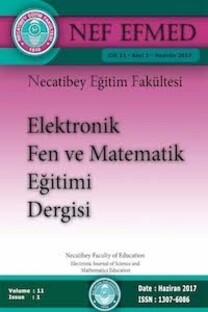The Impacts of a Secondary School Science Exhibition on the Students in Charge
The Impacts of a Secondary School Science Exhibition on the Students in Charge
___
- Best, S. (2007). Quaker events for young people: informal education and faith transmission. Quaker Studies, 11(2), 259-281.
- Borat, O. (2009). İnformal Öğrenme Sisteminin Kurulması İçin Örgün ve Yaygın Öğrenme Sistemlerinin İncelenmesi. MEB TTK Yayınları, 269-280.
- Braund, M. & Reiss, M. (2006) ‘Towards a more authentic science curriculum: the contribution of out-of-school learning’. International Journal of Science Education, 28 (12), 1373–1388.
- Crowley, K., Callanan, M., A., Galco, J., Topping, K. & Shrager, J. (2001). Shared scientific thinking in everyday parent - child activity. Science Education, 85(6), 712-732.
- Davidsson, E. & Jakobsson. A. (2009). Staff members’ ideas about visitors’ learning at science and technology centres. International Journal of Science Education, 31(1), 129– 146.
- DeWitt, J. & Osborne, J. (2010). Recollections of exhibits: Stimulatedrecall interviews with primary school children about science centre visits. International Journal of Science Education, 32(10), 1365-1388.
- Falk, J., & Storksdieck, M. (2005). Using the contextual model of learning to understand visitor learning from a science center exhibition. Science Education, 89(5), 744-778.
- Fernândez, G. & Benlloch, M.(2000).Interactive exhibits: how visitors respond. Museum International, 52(4), 53-59.
- Gebbels, S., Evans, S. M. & Murphy, L. A. (2010). Making science special for pupils with learning difficulties. British Journal of Special Education, 37(3), 139-147.
- Gönen, S. & Kocakaya, S. (2006). Fizik öğretmenlerinin öğretim etkinliklerine ve fizik ders kitaplarının içeriğine yönelik düşünceleri. Türk Fen Eğitimi Dergisi, 3(1), 86-96.
- Heard, P.F., Dival, S.A., & Johnson, S.D. (2000). Can ‘ears-on’ help hands-on science learning-For girls and boys?. International Journal of Science Education, 22(11), 1133- 1146.
- Hofstein, A. & Lunetta, V. N. (1982). The role of the laboratory in science teaching: neglected aspects of research. Review of Educational Research, 52(2), 201- 217.
- Karamustafaoğlu, S. (2003). Maddenin iç yapısına yoluculuk ünitesi ile ilgili basit araç- gereçlere dayalı rehber materyal geliştirilmesi ve öğretim sürecindeki etkililiği. Yayınlanmamış Doktora Tezi, Karadeniz Teknik Üniversitesi Fen Bilimleri Enstitüsü, Trabzon.
- Kelly, J. (2000). Rethinking the elementary science methods course: a case for content, pedagogy, and informal science education. International Journal of Science Education, 22(7), 755-777.
- Kırıkkaya, E. B. & Tanrıverdi, B. (2009). Fen laboratuvarlarının fiziki durumu ve laboratuvar uygulamalarına ilişkin öğretmen, öğrenci ve yönetici görüşleri. Milli Eğitim Dergisi, 182, 279- 297.
- Koç, A. ve Böyük, U. (2012). Basit malzemelerle yapılan deneylerin fene yönelik tutuma etkisi. Türk Fen Eğitimi Dergisi, 9(4), 102-118.
- Luehmann, A. (2009). Students’ perspectives of a science enrichment programme: out-ofschool inquiry as Access. International Journal of Science Education, 31(13), 1831- 1855.
- Martin, L., W. (2004). An emerging research framework for studying informal learning and schools. Science Education, 88(1), 71-82.
- Melber, L.H. & Abraham, L.M. (1999). Beyond the classroom: linking with informal education (Editorial). Science Activities, 36(1), 3-4.
- Miles, M. B. & Huberman, A. M. (1994). Qualitative data analysis. (2nd Edition). Thousand Oaks, CA: Sage.
- Nakamichi, M. (2007). Assessing the effects of new primate exhibits on zoo visitors’ attitudes and perceptions by using three different assessment methods. Anthrozoos:A Multidisciplinary Journal of The Interactions of People & Animals, 20(2), 155-165.
- Özdem, Y., Alper, U. ve Erar, H. (2012). Eğlenceli Bilim: Bilim Merkezlerinin İlköğretim Öğrencilerinin Bilimsel Süreç Becerilerine Etkisi. X. Ulusal Fen Bilimleri ve Matematik Eğitimi Kongresi, 27-30 Haziran, Niğde, Türkiye.
- Öztürk, G. (2007). Öğrencilerin basit malzemelerle yaptıkları deneylerin kuvvet-enerji kavramını öğrenmelerine ve fene karşı tutumlarına etkisi. Marmara Üniversitesi Eğitim Bilimleri Enstitüsü, Yüksek Lisans Tezi, İstanbul.
- Öztürk, Ş. (2009). Okulda eğitimle bütünleştirilmiş mekân dışı eğitim. Milli Eğitim Dergisi, 181.
- Pedretti, E. G. (2004). Perspectives on learning through research on critical issues-based science center exhibitions. Science Education, 88(1), 34-47.
- Rennie, L., J. & Williams, G., F. (2006). Adults’ learning about science in free-choice settings. International Journal of Science Education, 28(8), 871–893.
- Uzal, G., Erdem, A., Önen, F. & Gürdal, A. ( 2010), Basit araç gereçlerle yapılan fen deneyleri konusunda öğretmen görüşleri ve gerçekleştirilen hizmet içi eğitimin değerlendirilmesi. Necatibey Eğitim Fakültesi Elektronik Fen ve Matematik Eğitimi Dergisi, 4(1), 64-84.
- ISSN: 1307-6086
- Yayın Aralığı: 2
- Başlangıç: 2007
- Yayıncı: Balıkesir Üniv. Necatibey Eğitim Fak.
Fatih YAZICI, Mustafa SÖZBİLİR
Çevre Eğitimi Alanındaki Çalışmaların İncelenmesi: Türkiye’de Mevcut Durum
Esra Kızılay, Zehra KAPLAN, Serdar VARİNLİOĞLU, Kibar SUNGUR GÜL, MUSTAFA HAMALOSMANOĞLU, ORÇUN BOZKURT
The Impacts of a Secondary School Science Exhibition on the Students in Charge
ESİN ŞAHİN, NURAY ÖNDER ÇELİKKANLI
UZAMSAL GÖRSELLEŞTİRME ÜZERİNE BİR TEST GELİŞTİRME ÇALIŞMASI
NAZAN SEZEN YÜKSEL, Ali BÜLBÜL
Okul Öncesi Dönemdeki Çocuklara Yönelik Kavram Karikatürlerinin Geliştirilmesi ve Uygulanması
Şengül ATASOY, Muhammed Ali ZOROĞLU
GeoGebra Kullanımının Önlisans Matematik Öğretimine Etkinliğinin İncelenmesi
MUHAMMET DEMİRBİLEK, ABDULLAH ÖZKALE
Fatih YAZICI, MUSTAFA SÖZBİLİR
Web-Tabanlı Ortamda Öğretmen ve Akademisyenler Arasında Oluşturulan Bilgi Paylaşım Süreci
Öğrencilerin, Öğretmen Adaylarının ve Öğretmenlerin Yapılandırmacı Uygulamalar Hakkındaki Görüşleri
Pınar Seda CETİN, EBRU KAYA, Ömer GEBAN
Development and Application of Concept Cartoons for Preschool Children
